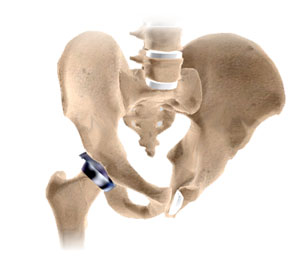
Hip resurfacing has evolved in the last eight years. The original hip resurfacing replacements were done 30 to 40 years ago and failed because of poor design and materials. Nowadays the design has significantly improved. Hip resurfacing is still a total hip replacement, however, it is more bone conserving leaving the femoral neck and head attached. If the hip fails then a revision standard total hip replacement can be performed without much difficulty.


Resurfacing a hip is similar to a total hip replacement from a surgical perspective. Instead of resecting the arthritic femoral head, the head is reshaped and resurfaced with a metal mushroom-like cap. This is cemented in place. The socket is prepared in a similar fashion to a total hip replacement. The socket is press-fitted into the acetabular bone and bone grows into the socket.
Risks of hip resurfacing replacement are similar to total hip replacement. In addition to those standard risks a hip resurfacing replacement may fail due to a femoral neck fracture or softening of the bone (avascular necrosis).
The advantages of hip resurfacing replacement include reduced dislocation, restores leg lengths, restores "normal anatomy" and the hip appears to be more durable allowing one to perform higher impact activity. The metal on metal technology has been present for the past 30 years and has proved successful.
Minimally invasive hip resurfacing replacement surgery and navigation:
Instruments have been designed that allow for smaller incision surgery. This is reflected in less tissue damage and slightly quicker recovery rates. The wounds are also a little smaller. It must be pointed out, however, that six months following the surgery there is no difference in the outcome between a standard incision hip and a mini incision hip.
Navigation is the latest technology that allows more accurate placement of the components to re-establish the normal hip biomechanics. This new technology is still evolving.
